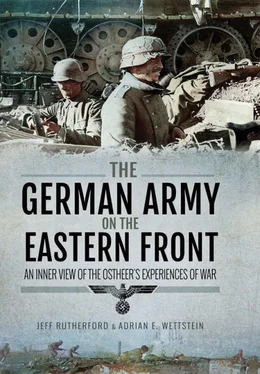During this time, when the very survival of the Eastern Army seemed in question, the army became much more radical in its approach to occupation policy. On the one hand, its scorched earth practices designed to stem the oncoming Soviet tide simply exposed civilians to the unforgiving elements. An order issued by XXXIXth Motorized Corps on 7 December 1941 ordered that ‘the city of Tichvin is to be destroyed as thoroughly as possible before the final pulling-out’ by German troops. [23]Its subordinate unit, the 8th Panzer Division, noted in its war diary that ‘destruction commandos’ needed to be established to carry out this order, to ensure that:
every house, every bridge, and every building that could be used as shelter is to be destroyed, without consideration for the inhabitants. Food and fodder that cannot be taken with the troops is likewise to be destroyed. [24]
By eliminating both shelter and food during the dead of winter, such policies obviously doomed countless Soviet civilians to death in late 1941 and early 1942. At the same time, fears of partisan attacks in the rear areas mushroomed during this period of crisis and the army responded by instructing its troops to maintain vigilance and inculcating in them ideological beliefs first mentioned in the pre-invasion orders, such as the ‘Guidelines for the Conduct of the Troops in Russia’. The following directive, issued by the 126th Infantry Division, highlights these points and also betrays the division commander’s anger at what he considered the unprofessional and lazy behaviour of the men under his control.
The fundamental guidelines for combating partisans are contained in the directive ‘The Commander-in-Chief of the Army, Gen. St. d.H./Ausb.Abt. (Ia) Nr. 1900/41 v. 25.10.41’, distributed on 10.11. to the battalion level. In addition to it, special points for partisan combat have once again been emphasized by the army. They are published below in excerpts and are to be followed.
1) Snow and ice, as well as murky, foggy weather with a prolonged darkness setting in very early, favours not only the possible appearance of enemy paratroopers, but also the operations of partisans and enemy raiding parties that usually close in on villages, highways, and railroads noiselessly on snowshoes, and can reach far behind the front.
All the greater must everyone’s vigilance and discipline be, even for those troops billeted far behind the front. Here, an incomprehensible naïveté is often especially found.
2) Every responsible commander and soldier must continually be clear that we are standing in enemy land and are dealing with an opponent whose character traits are treachery and insidiousness. Again and again, the Russian finds voluntary or forced support through the population. The trusting nature of the German soldier is all too often exploited to his harm. Caution and suspicion towards the Russian population is therefore necessary.
This includes not only the disarming and supervision of the inhabitants’ behaviour. Especially important is the constant checking of the numbers of the male as well as female population regarding comings and goings (agents, spies!)
All troops must learn to report unusual occurrences and suspected cases concerning agent activity, partisans and so on immediately to the counterintelligence agent at their superior command or directly to the Division’s section Ic [Intelligence].
3) All troops, and in this context this applies especially to those not deployed directly at the front, must take the necessary security measures against hit and run attacks. These require constant inspection and, where applicable, the modification through the responsible troop commander. Especially in cold and snow storms, the sentry must be particularly strictly supervised. Through frequent relief, the attention of the sentries should not be merely maintained, but rather increased.
[…]
5) Monitoring of the cross-country traffic also belongs to the guard and security service against partisans. This extends to:
a) Limiting traffic to a purely local ‘traffic’
b) Prevention of all traffic over wide areas
c) Examination of baggage and the sleds
d) Checking of passes.
These four points are to be continually checked through spot testing. Only through these means can one achieve the effective confrontation of the enemy’s means of intelligence transmissions – the fundamental prerequisite for all partisan and agent activity!
6) During a long stay in a village, the readiness and discipline of the troops is to be checked through frequent practice alarms. There should be no villages with troops in them that cannot immediately respond to surprise occurrences with prepared countermeasures.
The largest reproach is attached to the commander and the troops who have neglected blood-saving measures out of laziness. [25]
By emphasizing the fight against ‘an opponent whose character traits are treachery and insidiousness,’ and demanding the men take appropriate measures against such an enemy, the order suggests that the commander believed his men had been too lenient in their dealing with civilian population. Such a reading complicates a narrative that exclusively focuses on German brutality in the east. Nonetheless, it is also clear that civilians felt the sting of German occupation during the winter crisis, as the army implemented whatever policies it deemed necessary to survive the resurgent Red Army during the depths of winter.
The fate of Soviet soldiers taken captive by the German army provides perhaps the best example of how German policies in the occupied east evolved during the first two years of war. During the fighting of 1941, German operations culminated in large-scale encirclement battles in which over three million Red Army men were taken prisoner. German treatment of this massive number of men was simply criminal. Ideological beliefs – including the fear that Russian POWs were carriers of Bolshevism, as well as their alleged racial inferiority – intersected with pragmatic concerns – the disinclination to divert food intended for the army to prisoners and other logistic issues – to create the greatest mass mortality that the army was directly responsible for. More than two million men perished as a result of mass shootings, exposure to the elements, disease and, most importantly, starvation. [26]As the report reproduced above issued by the Eighteenth Army’s Chief Quartermaster in December 1941 illustrated, prisoners of war on the Eastern front were a commodity – only working prisoners were to receive the necessary rations to survive. This in and of itself was a revolutionary change in German policy towards Soviet POWs caused by the winter crisis and the realization that the war would stretch into 1942. Such a transformation of policy was reflected in a document issued to the 207th Security Division. As part of its mission in pacifying Estonia and a sliver of Russia-proper in the Lake Peipus region, the division dealt with prisoners of war. A rubric received by the division in December 1941 highlighted the daily deaths faced by POWs, the increasing use of such men for German labour projects, and the importance of race in determining treatment of prisoners: among those groups of prisoners released, ethnic Russians were conspicuously missing.
Monthly Report
A) Stock at the end of month following the model of appendix i
B) Arrivals in last month
a) pp.
b) in Army [Group] rear area
c) pp.
C) Left in last month
a) died, shot
b) escaped
c) given to the SD
d) given over to responsibility of Luftwaffe
e) given up to the OKW ’s POW organization
f) released
g) total
D) Labour Action on the first of the month
a) supply for the troops
b) road and bridge construction, street maintenance (without Organization Todt)
Читать дальше






![John Stieber - Against the Odds - Survival on the Russian Front 1944-1945 [2nd Edition]](/books/405234/john-stieber-against-the-odds-survival-on-the-russian-front-1944-1945-2nd-edition-thumb.webp)





